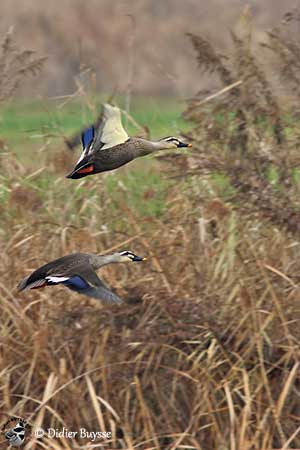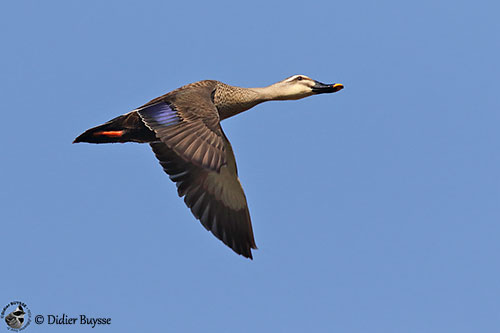
Fr: Canard de Chine
Ang: Eastern Spot-billed Duck
All: China-Fleckschnabelente
Esp: Ánade picopinto chino
Ita: Germano beccomacchiato orientale
Nd: Chinese Vlekbekeend
Sd: östlig fläcknäbband
Photographers:
Didier Buysse
Vision d’Oiseaux
Jean Michel Fenerole
Photos d’Oiseaux du monde
Ingo Waschkies
Bird Photography
Text by Nicole Bouglouan
Sources:
HANDBOOK OF THE BIRDS OF THE WORLD vol 1 by Josep del Hoyo-Andrew Elliot-Jordi Sargatal - Lynx Edicions - ISBN: 8487334105
GUIDE DES CANARDS, DES OIES ET DES CYGNES – de Steve Madge - Delachaux et Niestlé - ISBN: 2603013769
A Field Guide to the Birds of South-East Asia by Craig Robson. New Holland Publishers. ISBN: 9781780090498
What Bird-The ultimate Bird Guide (Mitchell Waite)
Wikipedia, the free encyclopaedia
South Dakota Birds and Birding – (Terry L. Sohl)
Eastern Spot-billed Duck
Anas zonorhyncha
Anseriformes Order – Anatidae Family
INTRODUCTION:
The Eastern Spot-billed Duck is a dabbling duck. It was formerly a subspecies of Anas poecilorhyncha from which it differs by its appearance, plumage colour and pattern. It was recognised as a separate species in 2008.
It breeds in eastern Asia from Siberia S to India and South East Asia, and winters S to the Philippines. It frequents freshwater lakes and marshes and feeds on plant materials, aquatic insects and molluscs. It nests on the ground, usually near water.
The Eastern Spot-billed Duck is widespread and common throughout its range, but it is affected by hunting pressure. However, it is not globally threatened for the moment.

DESCRIPTION OF THE BIRD:
Biometrics:
Length: 58-63 cm
Wingspan: 83-94 cm
Weight: M: 1000-1340 g – F: 750-980 g
The Eastern Spot-billed Duck is mainly dark grey-brown with paler head and neck. On the upperwing, the longest two tertials have white tips and narrow outer edges. The secondaries are dark bluish with very thin white borders, forming a blue speculum conspicuous in flight.
Head, neck and breast are whitish to buffy-white. Upperparts and underparts are grey-brown with white edges to feathers, involving scaled pattern. Vent, undertail and uppertail coverts are uniformly dark. The tail is dark brown with pale outer rectrices.
On the pale head, the crown is dark grey-brown. There is a black eyeline extending from lores to ear-coverts, and we can see a short, black malar stripe.
The bill is black with broad subterminal yellow band and black nail. The eyes are brown. Legs and feet are dull orange.
Male and female have similar plumage but the female is smaller. The male lacks eclipse plumage, but both adults moult after the breeding season.
The juvenile resembles adult but it is duller.
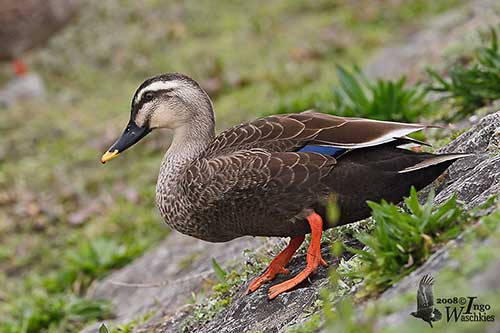
RANGE:
The Eastern Spot-billed Duck breeds in SE Russia, E Mongolia, Sakhalin, Korea and Japan to E China. It winters to S China and may reach Thailand and Cambodia.
HABITAT:
The Eastern Spot-billed Duck frequents freshwater lakes and marshes with abundant emergent vegetation. It can be found in both inland and coastal areas. It is usually seen in open, low ground, but on migration in SW China, it may reach at least 3,300 metres of elevation.
CALLS AND SONGS: SOUNDS BY XENO-CANTO
The calls of the Eastern Spot-billed Duck are similar to those of the Mallard, a typical quacking sound. Its repertoire is also very close to that of the Pacific Black Duck.
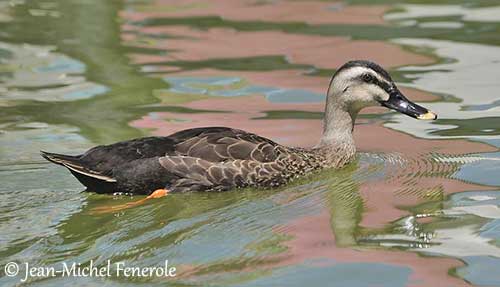
BEHAVIOUR IN THE WILD:
The Eastern Spot-billed Duck feeds primarily on seeds, part of grasses, sedges and aquatic vegetation. It may take aquatic insects and their larvae, worms and molluscs, especially water snails.
It feeds by dabbling and head-dipping in shallow water, or submerging the head while the tail is pointed up (upending). It also forages while walking about in marshland.
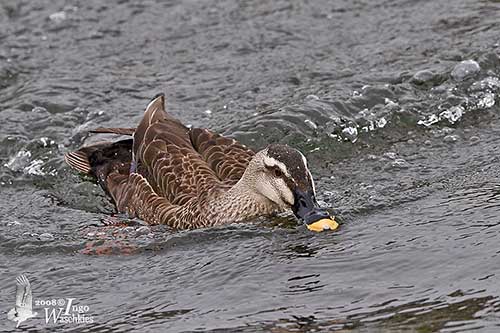
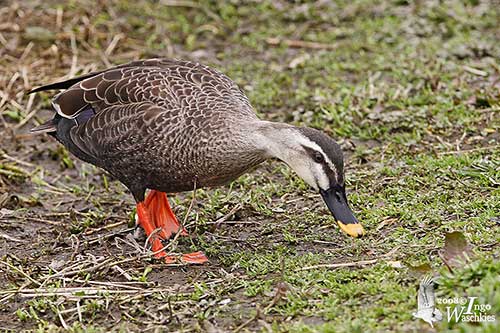
This species can be seen in pairs or in small groups, but flocks of up to 100 birds are occasionally observed.
The Eastern Spot-billed Duck nests on the ground, in single pairs or in loose groups. They probably have long-term pair-bond.
It is partially migratory. The northernmost populations migrate south to winter at lower latitudes, whereas those of tropical and more temperate regions are mostly sedentary. They may disperse, depending on water availability. The species has been observed as far as Alaska and in the Aleutian Islands, and also in other regions.
The flight is fast, direct and powerful, with rapid wingbeats.
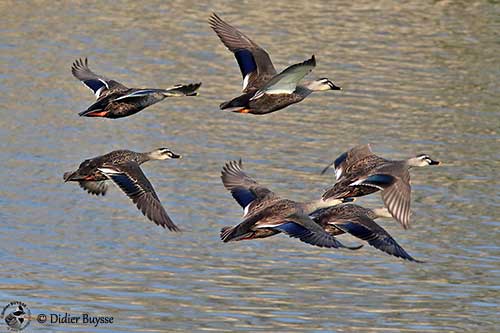
REPRODUCTION OF THIS SPECIES:
The breeding season usually varies, depending on range and water levels, but it takes place mainly between April and July.
The Eastern Spot-billed Duck breeds in single pairs or in loose groups. The nest is on the ground, often near water. It is made with grass and weeds, and lined with some feathers and down. It is often protected and hidden among the grassy vegetation, or occasionally placed in tree.
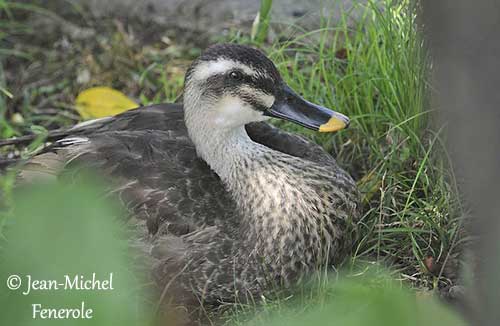
The female lays 7-10 white to greyish-white eggs. She incubates alone during 26-30 days, but the male remains in the vicinity of the nest to guard her.
At hatching, the chicks have dark brown down above and yellowish below, with some yellow markings on the back. The head pattern is like in adults. They fledge 50-56 days after hatching. Both parents rear and guard them until they become independent.
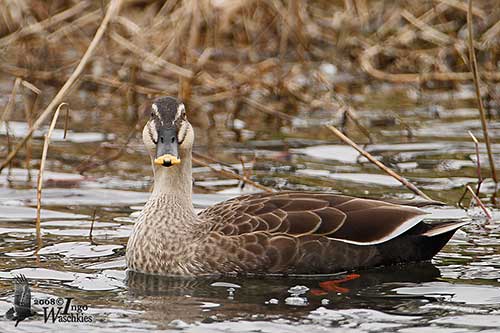
PROTECTION / THREATS / STATUS:
The Eastern Spot-billed Duck is common and widespread throughout its large range, but it is threatened by hunting pressure. However, this species appears adaptable and may frequent unusual habitats around rice fields in Japan where it breeds.
The global population is estimated to number 800,000/1,600,000 individuals, and it is suspected to be declining at moderate rate.
The Eastern Spot-billed Duck is currently evaluated as Least Concern.
